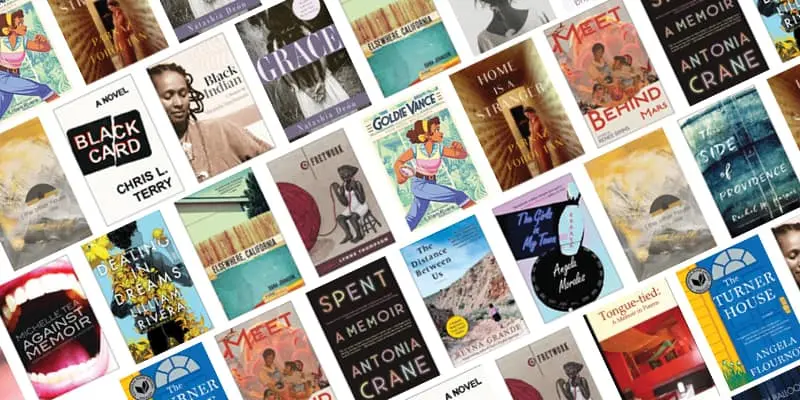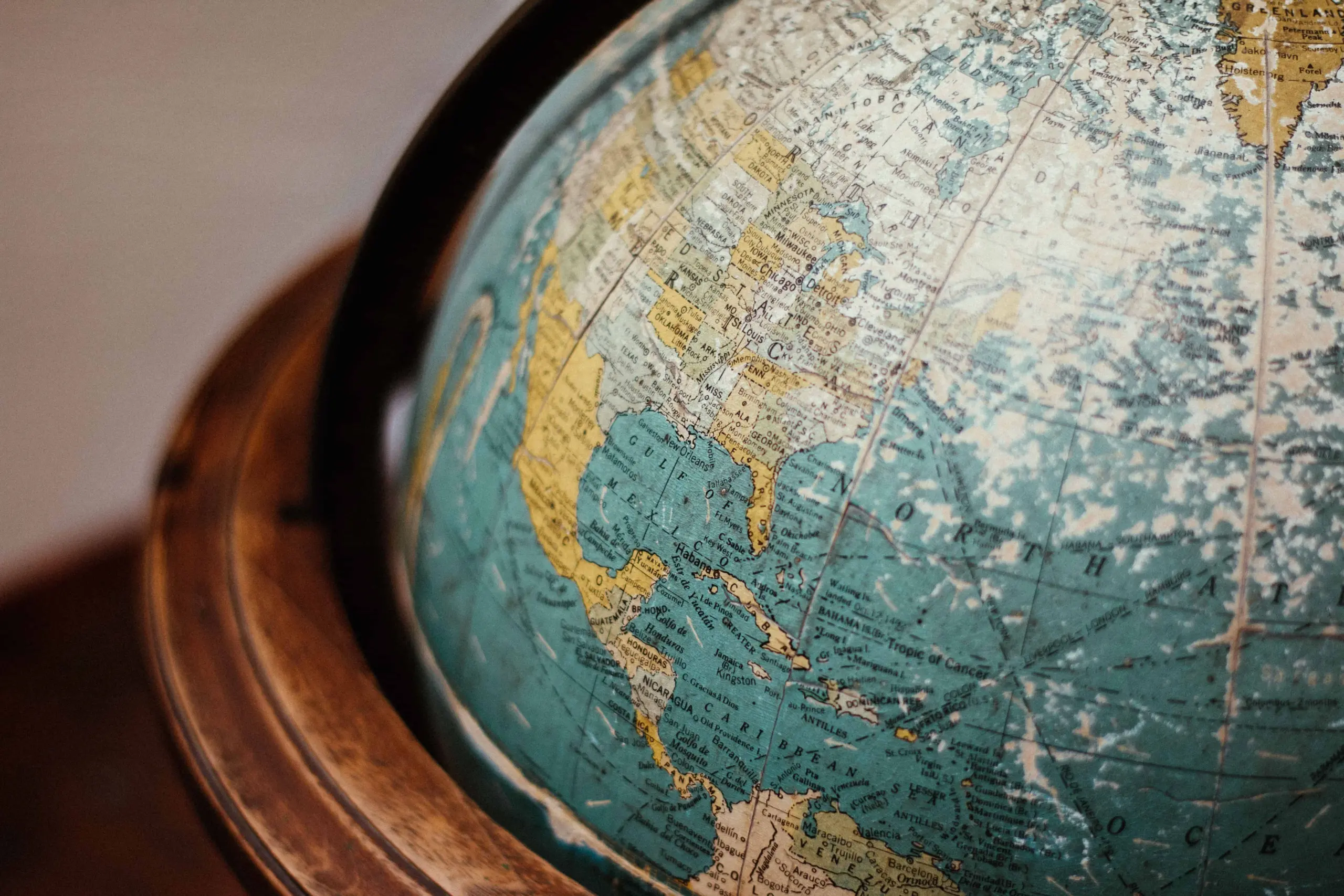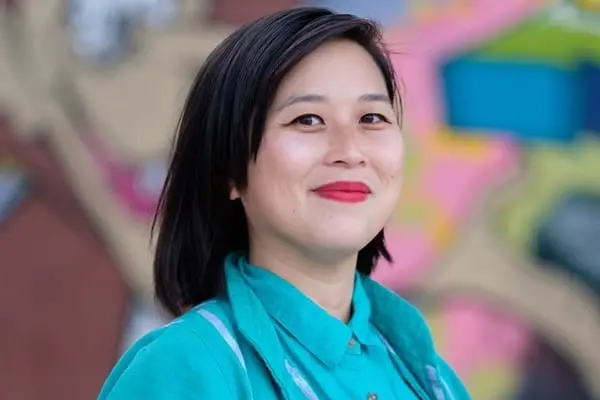This essay was written by 2020 Emerging Voices Fellow Megan Dorame at the culmination of the fellowship.

My identification as a Tongva poet is inextricably linked to my Tongva ancestors and my homeland. The Tongva homeland, also known as Tovaangar, encompasses the far reaches of the Los Angeles Basin: a territory that stretches north to Malibu, through the Santa Monica mountains, east to the San Gabriel and San Bernardino mountains, south to the Santa Ana mountains in Orange County, and west into the Pacific to the southern Channel Islands. All the land and water within these boundaries is the Tongva homeland. It’s this very land that appears regularly in my work as a focal point and metaphor for sovereignty in my poems.
For Native American tribes, sovereignty is the right for tribal nations to govern themselves. Individually, I exert my own sovereignty on the page by writing poems in a way that is not just inherently my own, but also, inherently Tongva. As I exercise my own self-determination on the page, I find that I’m able express ideas about tribal sovereignty through the use of poetic devices.
My work is informed by my experience as a modern Tongva person who grew up in Tovaangar. In my poems, I start with where I’m from because it colors the way I see the world. The central question I most often ask myself is the same question Tongva/Acjachemen scholar Charles Sepulveda asks in his article “Our Sacred Waters: Theorizing Kuuyam as a Decolonial Possibility,” which is: “what does it mean to live in a land you’ve been dispossessed of?”
Because the Tongva are not classified by the government as “federally recognized,” we do not have a land base, or any land that belongs solely to us. This also means that the federal government does not regard the Tongva as a nation, and does not engage with us in nation to nation dealings. Some of the implications of this non-federally recognized status is that we don’t have the rights or means to obtain land where we’re able to practice our culture freely. This affects our access to spaces where we might tend and gather ancestral plants for food and cultural items, practice ceremony, meet for language classes, or rebury our ancestors when they’re disturbed by development. This dispossession, in which our homelands no longer belong to us, exemplifies the modern Tongva experience. This experience is also impacted by the fact that Tongva history and presence in Los Angeles has effectively been erased. This feeling of invisibility has consistently been a force that compels me to write. With my poems, I hope to bring light to the experiences of my community.
In my own way, I counter Tongva loss and erasure by approaching the page as a space where I’m able to take back the land that was stolen from us. For example, in my epic poem “Pappaavetam / Water People,” I weave together several strands of Tongva oral histories that tell some version of a devastating flood, and in the merging of these histories, the lessons they teach are braided into a modern day story. In my reimagined version of the story, a flood overtakes the Los Angeles basin, resetting the imbalances that have occurred as a result of colonization. Similarly, in my poem, “Instructions for finding: Your way back: Instructions for finding: Your way forward: Instructions for finding: Los Angeles: Instructions for finding: We’aashar Chaavot,” I reclaim the land symbolically in the poem’s culmination, when an oak tree grows up from under the 101 freeway. This rise of the oak tree ultimately stops traffic as it breaks through the asphalt in the center of the freeway. This reclamation of space not only makes Los Angeles Tongva, but it gives agency back to the land. Further, a Tongva future is imagined where we have access to our ancestral foods such as the acorn, which comes from the oak tree, and the idea of food sovereignty is possible, if only, in a poem.
Another way I exert my sovereignty is the way I take up space on the page. In my long poem, “what blood is the salinity of saltwater?” I spread my words across the page, intentionally taking up as much space as possible in the section, “salinity : submerge (to rest on paper sheets is to dream underwater.)” I use this expansive form, and the placement of words on the page to achieve an undulating, underwater effect. The experience of this section is a journey that speeds up and slows down, while asking the reader to consider the discomfort of drowning. The drowning itself is a metaphor for the inherited trauma and everyday experiences colonized peoples face. In another section, “salinity : abalone as body,” I place words on the page to form the shape of an upside-down ovary as I examine the layers of my own inability to bring a child into the world. In contrast, at the beginning of this same poem, in the section, “salinity: salted earth,” I use narrow, one-inch columns with orderly, justified text to illustrate the confinement I feel in my homelands, in the sense that it can feel like there isn’t much space for Tongva people in our own homelands. The sweeping white across the page, which takes up the most space, symbolizes the settler colonial space that has taken over. I also use this device to acknowledge the confined space of nature within the greater Los Angeles area. The diminishing natural space in LA reflects the diminishing access the Tongva have to ancestral foods, medicines, and cultural ways of life.
Equally, my self-determination is reflected in the language I choose to fill a page with. As Mojave poet Natalie Diaz has said, when Native people write, we “use the white space that once silenced us.” I write against this historical silencing by choosing to use the Tongva language in my work; I see it as an act of resistance and resilience. Our language was stolen from us as three waves of colonization took place over a period of 150 years. The last fluent speaker of the Tongva language died over one hundred years ago, and what remains of the language today is what non-native anthropologists, linguists, and naturalists recorded, and ultimately, deemed important. Although today we have a dictionary and grammar book, the archive is extremely fragmented and left with many holes only a native speaker could fill.
It’s my belief that using the Tongva language breathes life into it. I try to fill in some of the missing pieces with creation, namely in the form of poems. I choose to make my poems multisensory by using Tongva words, whose sounds I find beautiful. For example, some of my favorite Tongva words place enunciation on short vowels, which creates a set of sounds that aren’t as common in English. In my poem, “Instructions…” I use sound in the refrain, “weaashar chaavot,” and the image this term translates to: oak light, is used as a motif in the refrain. This song-like quality can be disorienting or disarming to non-Native readers or listeners. However, I see this lyrical quality to my work as an ode to my ancestors, whose teachings have guided my life through song and oral narrative. This acknowledgement of my ancestors in “Instructions…” demonstrates my Tongva worldview, where time is nonlinear, and past, present and future play out simultaneously. As Tongva people, we are always remembering and interacting with our ancestors. To speak the Tongva language out loud is to speak to my ancestors because I know they can hear me. To use the Tongva language in my own work is to reclaim the Tongva language not just for myself, but for my ancestors and my community.
Tongva values I infuse in my work include reciprocity, respect, renewal, and relationships—with all beings. In my poems, I don’t just give agency to the land, I animate it, by intentionally giving voice to plants, animals, water and stones. This is most apparent in “Papaavetam / Water People,” where the speaker interacts with sycamore trees, pollywogs, and sea turtles, among others, on her journey to the sea. By giving voice to what non-Native folks may refer to as “inanimate objects,” I am sharing the Tongva worldview, where we are in relationship with all beings and we treat them as relatives.
In these acts self-determination on the page, I am not just decolonizing my craft, but I’m also recognizing that writing a poem is a communal act. The fact that it’s not just about me brings Tongva values to the forefront of my work. I write first for my people, with the hope that my writing validates the contemporary Tongva experience. Many of us are haunted by colonization and affected by it daily. I write about the pain of colonial violence in an effort to heal. While doing so, it’s my hope that my work will be able to remind non-Native folks that, as Cahuilla artist Gerald Clarke has said, “we are living on ancient land, and that we are an ancient people.” For me, my poems are a continuation of the material culture that is evidence of our presence here in Los Angeles for millenia.
The fact that the Tongva are still alive after state-sanctioned genocide makes our very existence inherently political. My work has evolved from a more activist, critical endeavor, where I implicate settler colonialism, to a mirror where I examine my own people, our history, as well as myself—the good, the bad, the ugly and the beautiful. This shift is apparent in my abalone poems, which started as a series of poems that indict the systems that have led to the decline of the abalone off the coast of California. In my newer poems about abalone, the speaker shapeshifts into an abalone as she confronts the intergenerational trauma behind her anxiety around becoming a mother.
Ultimately, in writing my poems, I am in control of the narrative. This counters a long history of non-Native folks not just writing about the Tongva, but also determining what’s valuable within the literary world. I make an honest effort not to pander to audiences outside of my own community, and I’m not interested in writing a poem to satisfy the literary establishment, make money or achieve status. Instead, my endeavor is to be honest about the pain of what’s been taken from us, while also focusing on the marvelous wonder that we, the Tongva are still here. In this time of COVID-19 and uprising, it’s become especially important for me to be radical in my imagining of a better future, not just for my own Tongva community, but also for everyone who calls Tovaangar their home.




